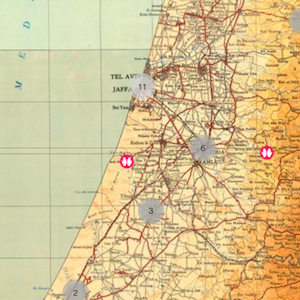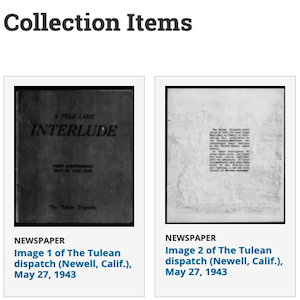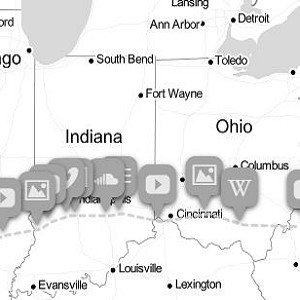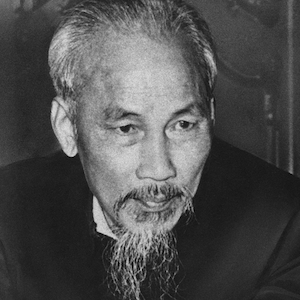Browse Website Reviews
Discover quality websites on a range of topics and time periods. If a website link is no longer active, consult this guide to website URL paths for tips on locating the original resource.

Heilbrunn Timeline of Art History
The Metropolitan Museum of Art's Heilbrunn Timeline of Art History is a reference, research, and teaching tool for students and instructors interested in global art history or teaching global history through art.
Mediateca INAH
Mediateca INAH facilitates virtual engagements with over half a million interrelated digital reproductions of maps, paintings, sculptures, photographs, audio recordings, documentaries, books, as well as other textual primary sources.
Palestinian Oral History Map
Drawing from thousands of hours of interviews from the Palestinian Oral History Archive (POHA), the map provides a stunning visual representation of Palestine in the 1940s, bringing interviewees’ memories of their lost homeland to life.
Lines of Struggle - Letters to President Lula
As a primary source, the letters offer an interesting and in many cases, moving glimpse into individual stories, feelings, and hopes that might not have necessarily been captured by larger, top-down historical narratives.
Japanese-American Internment Camp Newspapers
The Library of Congress’ collection of Japanese-American Internment Camp Newspapers is a rich, important archive that keeps the stories of the community and their experiences alive.
The Song Dynasty in China
What makes this module particularly interesting is its usage of a 12th century picture scroll as a means to explore various facets of Chinese life during this period.
Res Obscura
Functioning primarily as the personal blog of historian Benjamin Breen, Res Obscura stays true to its by-line by being ‘a catalogue of obscure things’.
The Chinese Railroad Workers in North America Project
The Chinese Railroad Workers in America Project is an excellent, multi-faceted model of how rigorous academic research can embrace the digital turn to interface with the public in a clear and accessible way.
Japanese Illustrated Books from the Edo and Meiji Periods
Spanning over three hundred years of Japanese book history, the collection includes famous Edo period (1603-1868) artists such as Andō Hiroshige (1797-1858) and Katsushika Hokusai (1760-1849).
Photo Library of the French School of Asian Studies
The EFEO has long been one of the leading centres of architectural, archaeological, epigraphic, ethnographic, and art historical research on Asia and this effort to digitise their extensive collection of photographs offers scholars and the public a new lens with which they can view a visually striking and rich region.
StoryMapJS: Maps that Tell Stories
A completed StoryMap will take you through a narrative that links text and media to locations on a map. Rather than simply clicking through points on a map, the tool is designed to create a narrative flow by clicking on an arrow to advance the story in a predetermined order.
Digital Archive: International History Declassified
An extensive repository that collects declassified archival records from all over the world, the Wilson Center's Digital Archive: International History Declassified is an essential resource for scholars, educators, and students interested in international history.
The Chinese Whispers
[The Chinese Whispers] serves as an important and powerful—if somewhat unconventional—primary source, allowing instructors and students to grapple with a variety of topics including Indonesian history, studies of the Overseas Chinese as a diasporic community, and notions of identity and belonging in diverse, multicultural populations.
Iceland Saga Map
Ultimately, the purpose of this map is to encourage and aid new readings of the sagas.
Latin American & Caribbean Digital Primary Resources
As a whole, the database serves the important goal of improving the accessibility of online libraries and archives. It provides a jumping off point for research into a variety of topics within Latin American history, and as it expands, its value will only increase
Freedom Narratives
Altogether, this free online website is an important resource for students and teachers who desire to understand biographical accounts and experiences of people from West Africa who fought to regain their freedom.
Liberated Africans
This website retraces the lives of over 250,000 people emancipated under global campaigns to abolish slavery, as well as thousands of officials, captains, crews, and guardians of a special class of people known as "Liberated Africans."
Patient No More
Not only does this site shed light on disability history, but the creators strove for universal accessibility as well. Thus, this resource caters to many learning needs.
Global Architectural History Teaching Collaborative
Perhaps most interesting and relevant for world history teachers and students are the modules that make connections across space and time.